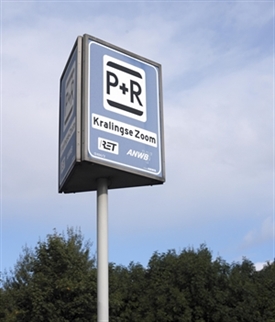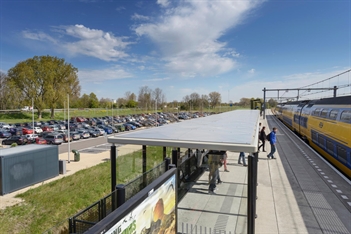Fact sheet Park+Ride
There are different types of P+R, each serving its own target group. An important differentiation is departure versus destination P+R sites. A departure P+R often has a larger parking facility at a train station. The largest part of the journey is made by train. A destination P+R is usually located near a motorway on the outskirts of a town or city. Most of the journey is made by car.
P+R sites are aimed at both commuters and infrequent visitors. Potential users of P+R areas can be targeted by roadside signs, coverage in the (local) media and promotional campaigns. P+R sites can reduce the pressure on parking in cities, reduce road congestion, contribute to a better environment, make the city centre more attractive and reduce the amount of parking space needed on the streets.
Accessibility effects
The Netherlands has more than 450 P+R sites (2015 figures). 282 of these are located at a local train station, 97 at a bus, tram or metro station (BTM) and 74 at an intercity station. The average capacity is 152 parking spaces, where sites at local train stations are significantly smaller, on average, than at the other locations (104 spaces versus 230 at intercity stations and 248 at BTM stations). The average occupancy rate at all P+R sites is around 60%.
The largest P+R sites are often those on the outskirts of large cities, near a bus, tram or metro station. In addition to a P+R function, these locations sometimes also serve as a parking facility for employees in the vicinity. The largest P+R site has a capacity of almost 1,300 spaces (Galgenwaard in Utrecht).
 Users of car parks at departure P+R locations yield relatively high savings in terms of car kilometres and rush-hour avoidance. At these kinds of P+R sites, on working days, almost everyone (95%) continues their journey by train. A large portion of them make rush-hour journeys. 80% do so in the morning rush-hour and 90% in the afternoon rush-hour. This leads to more than 1.5 instances of rush-hour avoidance per car park user (morning and/or evening rush-hour) on a large part of the entire route. Since commuters who use P+R sites have a long commuting distance on average (approx. 45 km), this also saves a relatively large number of car kilometres and the associated emissions.
Users of car parks at departure P+R locations yield relatively high savings in terms of car kilometres and rush-hour avoidance. At these kinds of P+R sites, on working days, almost everyone (95%) continues their journey by train. A large portion of them make rush-hour journeys. 80% do so in the morning rush-hour and 90% in the afternoon rush-hour. This leads to more than 1.5 instances of rush-hour avoidance per car park user (morning and/or evening rush-hour) on a large part of the entire route. Since commuters who use P+R sites have a long commuting distance on average (approx. 45 km), this also saves a relatively large number of car kilometres and the associated emissions.
People who use destination P+R sites still travel by car for a large part of their journey (usually often in rush-hour traffic in the case of commuters) and will therefore not avoid rush-hour traffic on the main road network, but will do so on the final part of their journey (often in city centres). If we calculate that each car park user results in half a rush-hour being avoided, the rule of thumb is that an average P+R site (departure and/or destination) will result in 1 instance of rush-hour avoidance per car park user per day.
An unintentional consequence of P+R sites is that they can encourage car traffic. Another (unintentional) consequence is that departure P+R sites can be used as destination P+R sites (and vice versa). This may result in a smaller decrease (or even a slight increase) in traffic than planned on road corridors, which were designed to protect the P+R sites.
Sustainability effects
In the case of a departure P+R site, where almost everyone would otherwise have travelled entirely by car, and consequently travelled an average of 90 km by public transport instead, the following emissions are saved on average per P+R car park user:
| CO2 | NOx | PM10 |
|---|---|---|
| 13.7 | 0.0097 | 0.00061 |
In the case of destination P+R sites, the sustainability effect is more limited, as only a small part of an entire journey is not (or is no longer) made by car. However, there may still be beneficial effects in the city centres. This has effects both in terms of a reduction in car use and the associated congestion and emissions, and in terms of space required, since parking is not in the city centres themselves but on the periphery.
Variables influencing effects
Motorists do not prefer P+R sites: they prefer to park in front of their final destination. The construction of a P+R site is therefore only useful in the case of:
- limited parking facilities and/or high parking tariffs at the final destination
- traffic jams on the roads
- a high quality public transport connection that is fast and inexpensive
Quality improvements to P+R sites (such as better lighting, more spacious areas and site cleanliness) will not immediately lead to a significant increase in the use of these sites by new or existing users. Only a small proportion (a few percent) of users of a P+R site will make more use of it, just because the quality has improved. However, improvements to a P+R site not only result in an improved perception of the site on the part of its users, but users also rate an entire journey from door-to-door more highly after improvements have been made. The likelihood of using the car again for the entire journey therefore decreases.
Motorists may be tempted to use P+R sites by promoting awareness and knowledge of sites and onward journeys by public transport. Awareness can be raised via signs along the road, especially if a P+R site is not visible from the road, possibly in combination with dynamic travel information and publicity in the (local) media. In any case, tariffs must also be shown online. In the case of a destination P+R site, the emphasis will have to be on convenience and price. In the case of a departure P+R site, more emphasis will have to be on the onward journey on public transport. Promotions, such as discounts on onward journeys on public transport, can introduce potential users to P+R sites, allowing them to experience the benefits.
Costs (including VAT)
The total construction costs per parking space, including legal, building and property costs, are based on a P+R site at ground level with 220 parking spaces, where free parking is available. Under those circumstances the average cost per parking space is €5,200. The bandwidth found here is €3,400-€6,900 (a one-off standard deviation). Where the P+R site is made up of multi-storey buildings, the average cost per parking space is €16,100, with a bandwidth from €12,700-€19,500.
In addition to the construction costs, there are annual operating, management and maintenance costs. A P+R site with 220 parking spaces above ground level costs between €25 and €125 per parking space. Where the P+R site has 220 parking spaces in a multi-storey building, the costs are between €125 and €250 per parking space.
In addition to the costs of P+R sites, in some cases there are also sources of revenue in the form of parking charges. These sources of revenue are often used to pay for public transport services (e.g. parking for €5, including four tickets to the city centre by public transport). Several variables have an impact on these costs:
- cost of land acquisition
- ground level / above-ground parking facilities (additional costs) / underground parking facilities (additional costs)
- size of P+R site (economies of scale)
- secure access (additional costs)
- location and length of the access road
- signage (with current occupancy rates and travel times, if applicable)
Mobility hubs
Over the past few years ‘mobility hubs’ have been on the rise. These days, towns and cities more often have a policy of restricting cars to the outskirts, and encouraging cycling and walking in town and city centres. So mobility hubs, essentially places for changing the mode of transport, are generally seen on the edges of towns and cities where it is possible to change to using the main road network or rail network. But hubs may also be in the city or, indeed, some distance from an urban centre.
Hubs are multi-modal and facilitate all sorts of transport in one place. So not just the combinations of parking and cycling (P+Bike) or parking and public transport (P+R). And they are often mentioned in combination with Mobility as a Service. The point of hubs is the focus on the location, not just in terms of functionality, but also in terms of attractiveness on many levels. Mobility hubs are still in their infancy and, at present, are being studied and developed in various places throughout the country.
More information
See https://wegwijs-beterbenutten.nl/pr-parkeren
Sources consulted
- Parkeren en gedrag, Een totaaloverzicht van alle relevante kennis op het gebied van parkeren en gedrag (CROW, 2017) - https://www.crow.nl/kennis/bibliotheek-verkeer-en-vervoer/kennisdocumenten/parkeren-en-gedrag
- Handboek P+R, Kennis voor beleid, beheer en praktijk (CROW 2015) https://www.crow.nl/publicaties/inspiratieboek-p-r
- Evaluatie maatregel MNBB56: ‘P+R Breukelen’, eindmeting (Goudappel Coffeng, 2015) - http://epomm.eu/maxeva/uploads/MNBB56_P_R_Breukelen_eindevaluatie.pdf
- BONroute, P+R terreinen in Noord-Holland en Flevoland; Het effect van uitbreidingen en een kwaliteitsimpuls, eindrapport (MuConsult, 2006)
- Potentieel Herkomst P+R Maastricht, Bekendheid en vindbaarheid, eindrapport (MuConsult, 2013)
- P+R en carpool, Dashboard duurzame en slimme mobiliteit (KPVV, 2013).https://kpvvdashboard-10.blogspot.nl/
- Aan de slag met P+R beleid, van strategie tot exploitatie (KPVV, 2005).https://www.crow.nl/documents/kpvv-publicaties/brochure-aan-de-slag-met-pr-beleid-van-strategie-t.aspx?ext=.pdf
Rules of thumb
- effect on accessibility: 1 (0.5-1.5) rush-hour journeys per day avoided
- impact on sustainability: reduction of 13.7 kg CO2 per car-park user per day at departure P+R sites
- costs: €3,400-€6,900 per parking space at ground level

